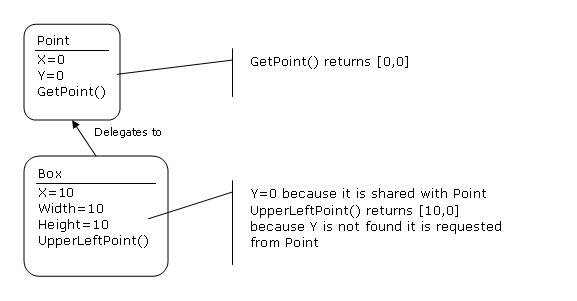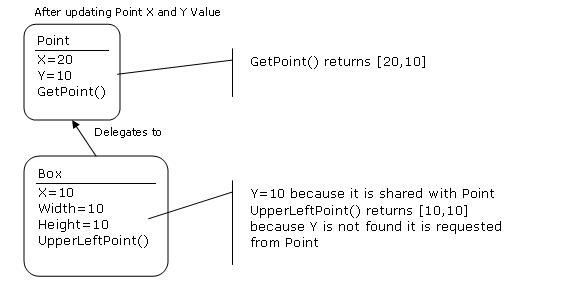CSC/ECE 517 Fall 2010/ch5 5c ck
Introduction
Dynamic dispatch means there is a determination of which method to execute at run time, when a class and one of it's subclasses have the same method signature.
This occurs when a class is downcast to one of its super classes and a method is called on the super class object.
Delegation
The mechanism for implementation of prototyping is called Delegation.[2]
'Operationally, delegation is the redirection of field access and method invocation from an object or prototype to another, in such a way that an object can be seen as an extension of another.' [7]
Delegation is a process whereby an existing object dynamically searches for properties and methods first within itself, then if an match is not found, it delegates that search to its parent object. The parent then repeats the exact same delegation process until a match is found. Once a match is found the result is returned to the requester.
Simple Example
This example demonstrates two objects that I always want aligned on the same y axis, however I want them to be independent on the x axis.

Box remains as is but Point is changed
NOTE: In the above example Box.GetPoint() would also return [10,10]. When GetPoint() searches for X it starts at the original requestors level and uses delegation just like the method search for Box.GetPoint().
While delegation is simple in its design, we will see that it is also elegant. In that it opens the door for several different techniques which allow software developers to morph an existing object, into a much larger and more robust object. While still retaining the original objects simplicity.
Competing Approaches
Class Approach
New objects are made from predefined classes. A class definition must exist to create an instance of a class. When a class is changed, existing objects must be reconstructed and we also need to ensure that nothing else in the application requires the prior classes constructed behavior.
Prototype Approach
New objects are constructed by copying an existing object. After copying we are safe to change the class behavior knowing that we are independent of all other objects. Prototyping is dynamic allowing us to create a real world object as a single instance and then refactor it at run time.
- We can add to it.
- We can remove parts from it.
- We can break parts out and move to a different location in the same delegation tree. Thereby extending the original behavior to more objects in the same object hierarchy.
Conclusion
The debate over which is better, class based OOD or prototype based OOD, has been around since the beginning of OOD. Prototype OOD appears to be gaining some mainstream ground, but it is still a long way from taking over traditional class based OOD. It is this authors opinion that this debate is ongoing and will exist in one form or another into the future. I believe that in the past 15 years, neither has proven to be advantagous in all circumstances over the other. I also believe that the evolution of some hybrid language features that attempt to bridge the gap will continue to evolve. I beleive that the future will at times lean in the direction of one or in the direction of the other, bull will never quite cuminate on one or the other.
